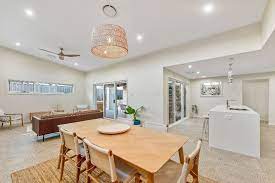Maximising Natural Light In Small Spaces
Small spaces can pose a decorating challenge, but with the right strategies, you can transform even the tiniest rooms into bright and airy sanctuaries. One of the key elements in achieving this transformation is harnessing the power of natural light.
Understanding the Importance of Natural Light
Before diving into specific tips, it’s crucial to understand why natural light matters. Natural light not only brightens up a space but also has numerous psychological and physiological benefits. Exposure to natural light can boost mood, improve sleep patterns, and increase overall well-being. In small spaces where every square inch counts, making the most of natural light becomes even more significant.
1. Choose Light Colours for Walls and Furniture
The colour palette you choose plays a significant role in how light interacts with your space. Opting for light and neutral colours on walls and furniture can make a room feel more open and reflective of natural light. Whites, pastels, and light shades of beige or grey are excellent choices. These colours bounce light around the room, creating an airy and spacious feel.
2. Use Mirrors Strategically
Mirrors are a well-known trick to amplify natural light in small spaces. Placing mirrors opposite windows reflects light and gives the illusion of a larger space. Consider using large mirrors or creating a mirrored accent wall to maximise this effect. Additionally, mirrored furniture can add a touch of glamour while serving the purpose of enhancing natural light.
3. Keep Window Treatments Simple
Heavy or dark window treatments can block precious sunlight from entering your space. Opt for lightweight curtains or blinds that allow natural light to filter through. If privacy is a concern, consider sheer curtains or blinds that maintain privacy without sacrificing brightness. Choosing the right window treatments can significantly impact the overall brightness and openness of a small room.
4. Trim Overgrown Outdoor Foliage
If your small space has access to an outdoor area, ensure that trees or bushes are trimmed regularly. Overgrown foliage can obstruct sunlight from entering through windows. By maintaining a well-groomed outdoor space, you ensure that natural light can freely flow into your interior, brightening up the room.
5. Declutter and Embrace Minimalism
Clutter can make a small space feel even smaller and darker. Embracing a minimalist approach to design not only enhances the aesthetic appeal but also allows for better light distribution. Keep surfaces clear and organised, and choose furniture with clean lines. A clutter-free environment reflects more light and creates a sense of openness.
6. Consider Skylights for Additional Natural Light
In the quest for maximising natural light, consider the installation of skylights. Skylights, also known as roof lights, are windows installed in the roof of a building to allow natural light to illuminate the interior. These fixtures are particularly beneficial for small spaces where wall windows might be limited. Skylights not only bring in additional light but also create an interesting architectural feature, adding a touch of uniqueness to your space. Just be sure to purchase from a reputable supplier such as tuffx.
7. Opt for Light-Colored Flooring
Just as light-coloured walls and furniture contribute to a brighter atmosphere, light-coloured flooring can have a similar effect. Light wood, laminate, or tile flooring reflects natural light, creating a seamless transition between the walls and the floor. This cohesive colour scheme contributes to the overall perception of a larger, brighter space.
8. Use Multi-Functional Furniture
In small spaces, every piece of furniture should serve a purpose. Opt for multi-functional furniture that not only fits the scale of the room but also enhances its functionality. Furniture with built-in storage can help keep the space organised, minimising clutter and allowing light to reach all corners of the room.
9. Install Translucent Doors
Incorporate doors with translucent or frosted glass panels to allow light to travel between rooms. This is especially effective in dividing spaces without sacrificing the flow of natural light. Translucent doors create a sense of continuity and openness while providing the necessary division between different areas.
10. Focus on Ambient Lighting
While maximising natural light is the primary goal, incorporating well-designed ambient lighting is essential for evenings or cloudy days. Choose lighting fixtures that complement the overall aesthetic of your small space. Pendant lights, wall sconces, or floor lamps with soft, diffused light can create a warm and inviting atmosphere.







